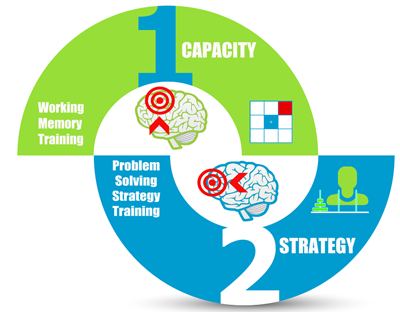i3 Mindware‘s second generation n-back training combines optional IQ problem training with working memory n-back training, to harness a scientifically known synergy between working memory activation and learning problem solving strategies.
i3 improves working memory. This 2014 article demonstrates the principle that working memory predicts the ability to learn problem-solving principles (‘mindware strategies’), explaining 63% of the variation in the ability to learn. This is the evidence behind the capacity-strategy synergy principle.
i3 Mindware’s Problem Sets
i3 Mindware incorporates 40 sets of optional brain-teasers that exercise fluid intelligence (Gf), verbal (crystallized) intelligence (Gc), visual-spatial processing (Gv), quantitative intelligence (Gq) and general intelligence (G). These are integrated into your 2G training sessions – one set per session. They are chosen to enable maximal learning of strategies for full-scale IQ tests.
Standard Working Memory Brain Training: Only Cognitive Capacity
Working memory training exercises such as the ‘standard’ (e.g. Jaeggi) n-back train working memory to increase working memory capacity. Working memory is the temporary storage system for information that is used ‘online’. Working memory training potentially expands your mind’s ‘workspace’ – the amount of information you can hold in mind and inter-relate to perform cognitive tasks like problem solving, decision-making, planning, comprehending or learning (review Morrison & Chein, 2011). The larger your working memory capacity, the more information and relationships you can process during reasoning and problem solving. (Carpenter et al. 1990).
What is Missing for Cognitive Performance: ‘Mindware’ Strategies
Your working memory capacity is like a computers RAM power. Having more RAM allows you to process more information faster, but it doesn’t help you know what rules and strategies to apply to the information in order to get the right results! It doesn’t help you overcome biases in how you reason, for instance. And it doesn’t help you solve problems unless you know the right strategies to apply to the problem. To learn how to do a mathematical calculation, you need to learn mathematical rules; to learn how to drive a car, you need to learn how to operate the car; to learn a second language, you need to apply grammatical rules. For overall cognitive performance, you need both cognitive capacity (a measure of the efficiency of your brain), as well as the right ‘mindware‘ – knowledge, know-how, rules, procedures and mental strategies.
“MINDWARE, a term coined by Perkins (1995), refers to the rules, procedures and strategies that can be retrieved by the analytic system.” Stanovich & West, 2008[
Capacity-Strategy Synergy
A larger working memory capacity functions to allow for easier learning and application of mental mindware.
Working memory circuitry is located in the lateral prefrontal cortex. Activation in this area allows for the flexible application of a wider range of novel strategies and rules [reference], overcoming automatic responses, and these new rules – with practice – are then more effectively encoded in more anterior (to the front of the head) prefrontal areas [reference]. This is shown in the ‘Capacity-Strategy’ infographic below.




